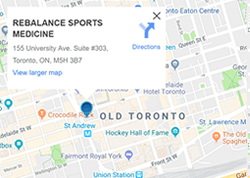Strengthen Your Core
 If you suffer from mild to debilitating back pain and have seen a physiotherapist, I have no doubt that you have been told to strengthen your core. Some patients with peripheral injuries may have also been instructed to strengthen their core.
If you suffer from mild to debilitating back pain and have seen a physiotherapist, I have no doubt that you have been told to strengthen your core. Some patients with peripheral injuries may have also been instructed to strengthen their core.
Well, you could very well ask why? Here are 3 reasons given by Dr. Stuart McGill. #1) stiffness of the lumbar spine and core enhances distal athleticism and limb speed – the stiffer the spine the more energy will be transferred to the limbs for athletic tasks, #2) a muscular guy wire system is essential for a flexible spine to bear load and #3) muscular coactivation creates stiffness in the spine to eliminate micromovements in the joints that lead to pain – these micromovements occur because injury causes laxity to joints and tissues.
Below are examples of the beginner versions of Dr. Stuart McGill’s “big three” exercises. These exercises are evidence based and have been shown to strengthen the muscles that stiffen the spine without putting too much load on the spine.
- Curl up – the basic starting position is supine with the hands supporting the lumbar region. The back should not be flattened. From here, bend one knee to 90 degrees and leave the other leg straight out. The focus of the rotation is in the thoracic spine. Do not flex your neck but rather move your head and neck as a rigid unit on the thoracic spine. The intention is to contract the rectus abdominus muscles and the obliques without moving the spine. The tongue should be placed on the roof of the mouth behind the front teeth and pushed upward to stabilize the neck. Elbows should be left on the floor.


- Side Bridge – Beginners bridge from the knees. Lie on one side with the knees bent to 90 degrees and the body supported through the elbow and the hip. Place the free hand on the opposite shoulder and pull down to help stabilize that shoulder. The torso is straightened until the body is supported by the elbow and the knee.


- Bird dog – The starting position is on the hands and knees with the knees under the hips and the hands under the shoulders. The spine should be in neutral (a slight lordosis). Lift one hand or knee about an inch off the floor. Make sure that the spine isn’t going into an excessive lordosis, twisting of flexing, maintain that neutral position


Dr. McGill suggests that you do not hold the positions longer than 7 or 8 seconds given the research that shows rapid reduction of oxygen available to the torso muscles when contracting at these levels. Short relaxation of the muscle restores oxygen. To build endurance, do more repetitions rather than longer holds.
References:
- McGill, Stuart. Low Back Disorders: Evidence-Based Prevention and Rehabilitation. Human Kinetics, 2016.
Rebalance Toronto
Rebalance Sports Medicine is a multidisciplinary clinic in downtown Toronto offering physiotherapy, chiropractic, registered massage therapy, sports medicine, naturopathy, Pilates and more.









 What to Expect From Your First Physiotherapy Visit
What to Expect From Your First Physiotherapy Visit The Benefits of Fascial Stretch Therapy [Demo]
The Benefits of Fascial Stretch Therapy [Demo] How Does Physiotherapy Work?
How Does Physiotherapy Work? Best Exercises for Low Back Pain
Best Exercises for Low Back Pain